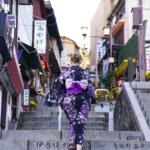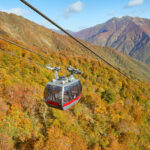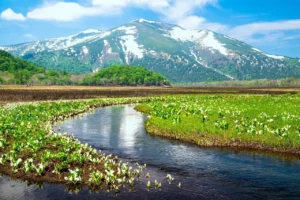
Tucked away in the mountains where Gunma, Fukushima, Niigata, and Tochigi Prefectures meet, Oze National Park is one of Japan’s most beautiful and unspoiled natural landscapes. Known for its vast wetlands, tranquil mountain views, and spectacular seasonal colors, Oze offers visitors a chance to experience the country’s pristine highlands much as they existed centuries ago.
This national park is a paradise for hikers, photographers, and nature lovers, providing a rare opportunity to explore Japan’s wilderness through carefully preserved wooden boardwalks and scenic mountain trails.
Contents
Overview and History
Oze was first protected as part of the Nikko National Park in 1934, but its ecological importance and distinct geography led to its designation as a separate national park in 2007. It covers about 37,200 hectares and includes the Ozegahara Marsh, Ozenuma Lake, and several surrounding peaks such as Mount Shibutsu (2,228 m) and Mount Hiuchigatake (2,356 m)—the highest mountain in the Tohoku region.
The park is celebrated as a symbol of Japan’s modern environmental movement. In the 1950s, citizens successfully protested plans to dam the area, leading to its preservation and marking one of Japan’s first major conservation victories.
The Heart of Oze – Ozegahara Marsh
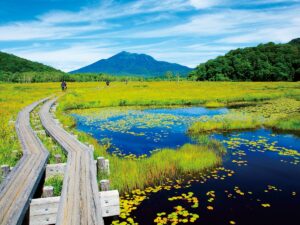
The Ozegahara Marsh is the most iconic part of the park—a wide, flat wetland valley surrounded by towering mountains. Spanning about 8 square kilometers, it’s Japan’s largest high-altitude marsh, located approximately 1,400 meters above sea level.
Wooden boardwalks crisscross the marsh, allowing visitors to walk comfortably while protecting the delicate ecosystem. In spring, the marsh bursts into life with the mizubashō (Asian skunk cabbage) in full bloom, creating white carpets of flowers against the lingering snow.
In summer, the area glows with yellow daylilies, while autumn transforms the marsh into a tapestry of gold, crimson, and orange. Each season offers a completely different atmosphere, making Oze a place worth revisiting.
Ozenuma Lake
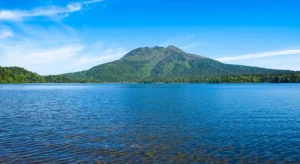
Further north lies Ozenuma, a serene mountain lake fed by the marsh’s rivers. It’s encircled by a gentle hiking trail that takes about three hours to complete. Along the way, visitors can enjoy reflections of Mount Hiuchigatake mirrored on the water’s surface—a photographer’s dream, especially during the morning mist or autumn foliage.
Several lodges and rest houses line the lake, offering light meals, tea, and stunning views.
Hiking and Trails
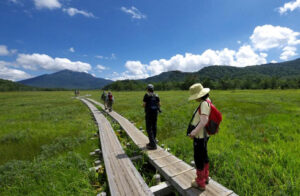
Oze is a car-free national park—one of the few in Japan. To preserve its fragile environment, private vehicles are not allowed inside. Visitors must enter via one of several trailheads and hike or take shuttle buses to the main marsh area.
Popular hiking routes include:
-
Hatomachi Pass → Ozegahara → Yamanohana (5–6 hours)
-
The classic Oze route, featuring wooden boardwalks across the marsh.
-
-
Numayama Pass → Ozenuma → Ozegahara (6–7 hours)
-
A scenic route starting from the Fukushima side, passing through Ozenuma Lake.
-
-
Climb Mount Shibutsu (2,228 m)
-
A challenging half-day trek offering panoramic views over the marsh.
-
The trails are well-marked and suitable for beginners, though elevation changes can be steep in certain areas.
Flora and Fauna

Oze’s ecosystem supports more than 900 species of plants and numerous animal species, including deer, foxes, and various alpine birds. In spring and summer, the wetlands are dotted with blooming flowers such as mizubashō, nikkōkisuge (daylily), and cottongrass, while the forests are home to rare mosses and ferns.
Because of its biodiversity, Oze has been designated as a Special Natural Monument of Japan and part of the Ramsar Convention on Wetlands.
Accommodation and Facilities
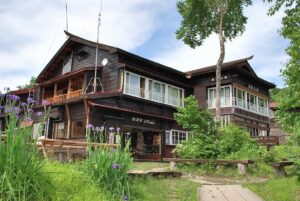
There are no hotels inside the park, but visitors can stay in:
-
Mountain lodges and huts around the marshes and lakes
-
Guesthouses and inns near the trailheads in towns like Tokura, Katashina, and Hinoemata
Many lodges offer Japanese-style meals, futon bedding, and hot baths using local spring water. Reservations are essential, especially during the blooming and autumn foliage seasons.
Camping is allowed only in designated areas.
Best Time to Visit
-
Late May–June: Mizubashō (skunk cabbage) bloom and fresh green season
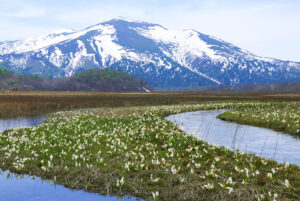
-
July–August: Mild weather, daylilies, and alpine flowers
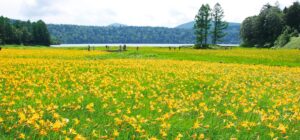
-
Late September–October: Brilliant autumn foliage
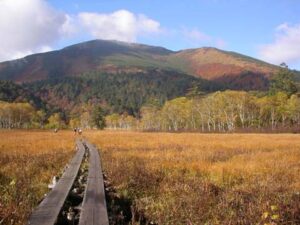
-
Winter (November–April): Closed due to heavy snow
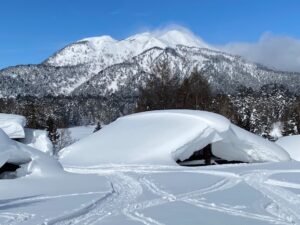
Because the park lies at high elevation, even summer mornings can be chilly, so layers are recommended.
How to Get There
From Tokyo:
-
Take the Joetsu Shinkansen to Jōmō-Kōgen Station (about 75 minutes).
-
From there, take a bus to Tokura or Hatomachi Pass (approx. 2 hours).
-
Continue on foot into the park.
From Aizu-Kawaguchi (Fukushima side):
-
Take the JR Tadami Line and local bus to Numayama Pass trailhead.
Note:
Cars cannot enter Oze National Park. Shuttle buses and taxis operate between parking areas and trailheads.
Tips for Visitors
-
Bring water and snacks – food is only available at limited rest houses.
-
Wear proper hiking shoes – boardwalks can be slippery when wet.
-
Carry rain gear – weather can change rapidly in the mountains.
-
Do not pick flowers or feed wildlife – this is a strictly protected area.
-
Take your trash back with you – there are no bins inside the park.
Why You Should Visit
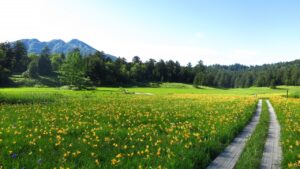
Oze National Park is more than just a scenic destination—it’s a living symbol of Japan’s deep respect for nature. Its misty marshlands, mirror-like lakes, and untouched mountains evoke a sense of quiet timelessness that few other places can match.
Whether you’re hiking the wooden paths, watching morning fog roll over the wetlands, or simply breathing in the crisp mountain air, Oze offers a profound reminder of how humans and nature can coexist in harmony.
A visit to Oze is not just a journey through Japan’s wilderness—it’s a step into the soul of the country itself.
Official Website
https://oze-fnd.or.jp/en/
Related articles
Accommodation sites
Agoda
